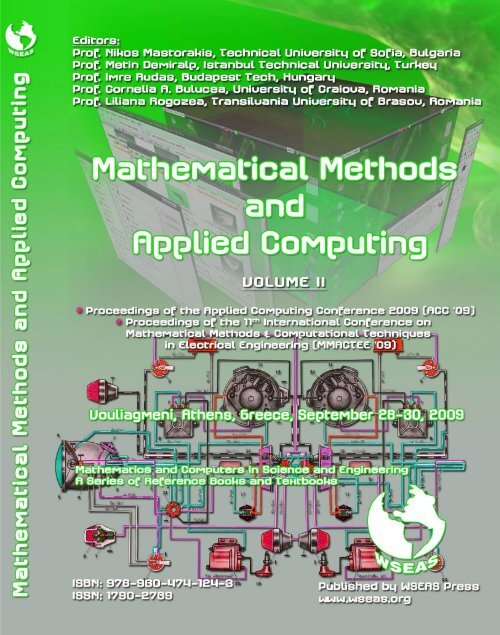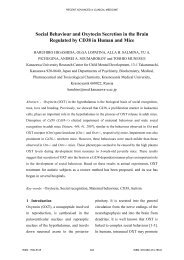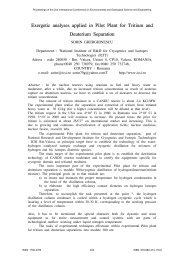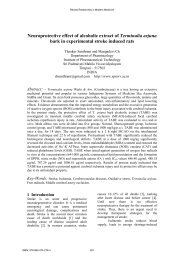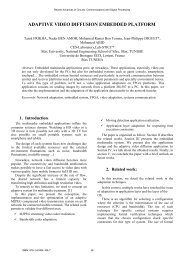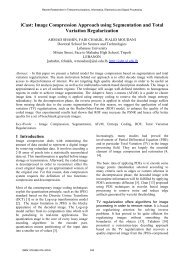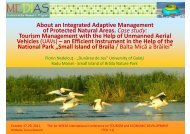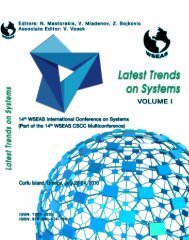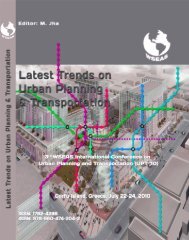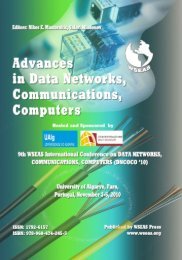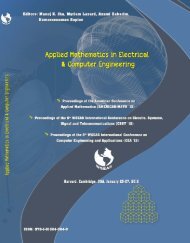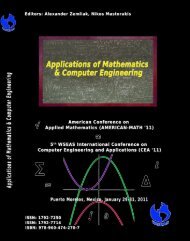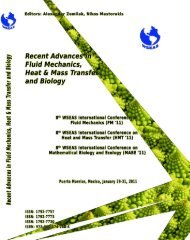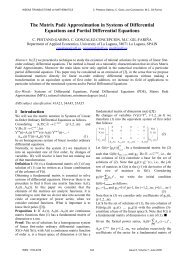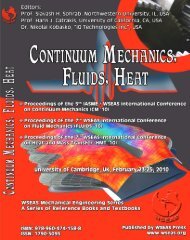Mathematical methods and - Wseas.us
Mathematical methods and - Wseas.us
Mathematical methods and - Wseas.us
You also want an ePaper? Increase the reach of your titles
YUMPU automatically turns print PDFs into web optimized ePapers that Google loves.
MATHEMATICAL METHODS ANDAPPLIED COMPUTINGVolume IIProceedings of the APPLIED COMPUTING CONFERENCE 2009(ACC '09)Proceedings of the 11th International Conference onMATHEMATICAL METHODS AND COMPUTATIONALTECHNIQUES IN ELECTRICAL ENGINEERING(MMACTEE '09)Vouliagmeni, Athens, GreeceSeptember 28-30, 2009Mathematics <strong>and</strong> Computers in Science <strong>and</strong> EngineeringA Series of Reference Books <strong>and</strong> TextbooksPublished by WSEAS Presswww.wseas.orgCopyright © 2009, by WSEAS PressAll the copyright of the present book belongs to the World Scientific <strong>and</strong> Engineering Academy <strong>and</strong>Society Press. All rights reserved. No part of this publication may be reproduced, stored in a retrievalsystem, or transmitted in any form or by any means, electronic, mechanical, photocopying, recording, orotherwise, without the prior written permission of the Editor of World Scientific <strong>and</strong> Engineering Academy<strong>and</strong> Society Press.All papers of the present volume were peer reviewed by two independent reviewers. Acceptance wasgranted when both reviewers' recommendations were positive.See also: http://www.worldses.org/review/index.htmlISSN: 1790-2769ISBN: 978-960-474-124-3World Scientific <strong>and</strong> Engineering Academy <strong>and</strong> Society
MATHEMATICAL METHODS ANDAPPLIED COMPUTINGVolume IIProceedings of the APPLIED COMPUTING CONFERENCE 2009(ACC '09)Proceedings of the 11th International Conference onMATHEMATICAL METHODS AND COMPUTATIONALTECHNIQUES IN ELECTRICAL ENGINEERING(MMACTEE '09)Vouliagmeni, Athens, GreeceSeptember 28-30, 2009
Editors:Prof. Nikos Mastorakis, Technical University of Sofia, BulgariaProf. Metin Demiralp, Istanbul Technical University, TurkeyProf. Imre Rudas, Budapest Tech, HungaryProf. Cornelia A. Bulucea, University of Craiova, RomaniaProf. Liliana Rogozea, Transilvania University of Brasov, RomaniaInternational Program Committee Members:Leonid KazovskyCharles LongKatia SycaraRoberto RevetriaM. Isabel Garcia-PlanasMiguel Angel Gomez-NietoAkshai AggarwalPierre BorneGeorge StavrakakisAngel Fern<strong>and</strong>o Kuri MoralesArie MaharshakFumiaki ImadoSimona LacheToly ChenIsak TaksaG. R.DattatreyaBranimir ReljinPaul CristeaRonald YagerAmauri CaballeroGeorge VachtsevanosRobert FinkelDemetrios KazakosTheodore TrafalisTakis KasparisZhiqiang GaoYan WuSpyros TragoudasArkady KholodenkoGregory BakerGaligekere DattatreyaCaroline SweezyAsad SalemDian ZhouOlga MartinPanos PardalosConstantin UdristeKleanthis PsarrisAndrew D. JonesValeri MladenovF. NeriS. Y. ChenShyi-Ming ChenK. YenRong-Jyue FangArgyrios VaronidesNikolai KobaskoAnping XuH. Zhu
PrefaceThis year the APPLIED COMPUTING CONFERENCE 2009 (ACC '09) <strong>and</strong> the 11thInternational Conference on MATHEMATICAL METHODS AND COMPUTATIONALTECHNIQUES IN ELECTRICAL ENGINEERING (MMACTEE '09) were held inVouliagmeni, Athens, Greece, September 28-30, 2009. The conferences remain faithful to theiroriginal idea of providing a platform to disc<strong>us</strong>s algorithms, automata, formal languages,programming languages, software engineering, artificial intelligence, computational intelligence,real time <strong>and</strong> embedded systems, circuits, networks, electronics, microelectronics,nanoelectronics, automation, control, robotics etc. with participants from all over the world, bothfrom academia <strong>and</strong> from ind<strong>us</strong>try.Their success is reflected in the papers received, with participants coming from several countries,allowing a real multinational multicultural exchange of experiences <strong>and</strong> ideas.The accepted papers of these conferences are published in this Book that will be indexed by ISI.Please, check it: www.worldses.org/indexes as well as in the CD-ROM Proceedings. They willbe also available in the E-Library of the WSEAS. The best papers will be also promoted in manyJournals for further evaluation.A Conference such as this can only succeed as a team effort, so the Editors want to thank theInternational Scientific Committee <strong>and</strong> the Reviewers for their excellent work in reviewing thepapers as well as their invaluable input <strong>and</strong> advice.The Editors
MATHEMATICAL METHODS AND APPLIED COMPUTINGTable of ContentsKeynote Lecture: High Dimensional Model Representation(s) as Multilinear ArrayDecomposition Method(s)Metin DemiralpPlenary Lecture 1: Formal Testing Approach for the Conformance <strong>and</strong> Interoperability ofMANET Routing ProtocolsStephane Maag1920Plenary Lecture 2: Immune Network <strong>and</strong> Adaptive Control 21Mari<strong>us</strong>-Constantin PopescuPlenary Lecture 3: Monte Carlo Cellular Automaton Simulation in Biomedical Science:Cancer Research <strong>and</strong> Min Protein DynamicsYongwimon LenburyPlenary Lecture 4: Visualization <strong>and</strong> Interaction of the Virtual Human Organs for the PreoperativePlanningLucio Tommaso De Paolis2223Plenary Lecture 5: Potential Method in the Performance Evaluation of a Network Node 24Andrzej ChydzinskiPlenary Lecture 6: Simulation of Power Plants <strong>and</strong> Energy Conversion Systems 25Reinhard LeithnerPlenary Lecture 7: Electronic Health Record from an A<strong>us</strong>tralian Perspective 26Eugene LuttonPlenary Lecture 8: Decision Precising Technologies in Decision Making Systems 27Gia SirbiladzePlenary Lecture 9: Iterative Numerical Methods for Simulation of Coupled EngineeringProblemsIon CarsteaPlenary Lecture 10: Camp<strong>us</strong> Web based Information System for Monitoring Quality of Life: ACase Study Applied to the University of MinhoRui Antonio Rodrigues Ramos2829Plenary Lecture 11: The Operating Risk Assessment for Dependable Systems 30Gabriela TontPart I 31The C Compiler Generating a Source file in VHDL for a Dynamic Dataflow Machine 33Jorge Luiz E. Silva, Kelton A. P. Da Costa, Valentin Obac RodaAn Empirical Analysis of Convergence Related Particle Swarm Optimization 37Milan R. Rapaic, Zeljko Kanovic, Zoran D. JelicicISSN: 1790-2769 9 ISBN: 978-960-474-124-3
MATHEMATICAL METHODS AND APPLIED COMPUTINGEnergy Consumption Forecasting in Process Ind<strong>us</strong>try Using Support Vector Machines <strong>and</strong>Particle Swarm OptimizationMilena R. Petkovic, Milan R. Rapaic, Boris B. Jakovljevic43Lightweight Mix Columns Implementation for AES 48Eslam Gamal Ahmed, Eman Shaaban, Mohamed HashemCSCA-Based Expectivity Indices for LIDAR-Based Computer Vision 54Donald J. McTavish, Galina Okouneva, Aradhana ChoudhuriA New Paradigm: Web 2.0 Mashup Patterns 62Cheng-Jung Lee, Shung-Ming Tang, Chang-Chun TsaiModeling Multicomponent Vapor-Liquid Diff<strong>us</strong>ion at High Pressure Including ConvectiveEffects in the Vapor PhaseElif Solak, Gulcin Cem, Betul Unl<strong>us</strong>u68Optimality <strong>and</strong> Stability Criteria for Software Testing Process Control Model 73Ljubomir Lazic, Nikos E. MastorakisImplementation <strong>and</strong> Application of Extended Precision in Matlab 103Z. L. Krougly, D. J. JeffreyEffect of Artificial Viscosity on Central Finite Volume Solution of Time-DependentConcentration Diff<strong>us</strong>ionSaeed-Reza Sabbagh-Yazdi, Mohammad-Amin Panahkhahi, Nikos E. Mastorakis109High-Level Secured Signature Scheme 115Nicolae Constantinescu, Costin BoldeaMonte Carlo Cellular Automaton Simulation in Biomedical Science: Heterodimerization ofReceptorsA. Wisitsorasak, W. Triampo, D. Triampo, C. Modchang, Y. Lenbury119Comparison of Feature Detectors for Rover Navigation 126Aldo Cumani, Antonio GuiducciReturn on Investment in B<strong>us</strong>iness Intelligence in Small <strong>and</strong> Mid-Sized B<strong>us</strong>inesses 132Zeljko PanianMiddleware Mechanisms for Dependable Network Services in a Distributed Processing System 138Matei Dobrescu, Manuela Stoian, Cosmin LeoveanuDo B<strong>us</strong>iness Intelligence Systems Actually Improve Information Quality? 144Jurij Jaklic, Pedro Simoes Coelho, Ales PopovicA Modified SOM Learning Algorithm for Mixed Types of Symbolic <strong>and</strong> Fuzzy Data 150De-Hua Chen, Miin-Shen Yang, Wen-Liang HungTemporalized Dempster-Shafer belief Structure in Discrimination Analysis 156Anna Sikharulidze, Gia SirbiladzeFuzzy Covering Problem Based on the Expert Valuations 163Gia Sirbiladze, Anna Sikharulidze, Bezhan GhvaberidzeISSN: 1790-2769 10 ISBN: 978-960-474-124-3
MATHEMATICAL METHODS AND APPLIED COMPUTINGA New Method for Designing Network Management System 171Yanjun Zhao, Jinrong Tong, Mao ZhanDesign of Autonomo<strong>us</strong> Control System for Underwater Vehicles 176Jinrong Tong, Yanjun ZhaoA Forward Secure Direct Anonymo<strong>us</strong> Attestation Scheme 182Deng-Guo Feng, Jing Xu, Xiao-Feng ChenAssessment of Improved Transformer Thermal Models 189Eleonor Stoenescu, Mari<strong>us</strong> C. Popescu, Cornelia A. BuluceaSimulations of Oil-filled Transformer Loss-of-Life Models 195Florentina Ilie, Cornelia A. Bulucea, Mari<strong>us</strong> C. PopescuImplementation of New Solution Software for Three Tank System Control 202Mari<strong>us</strong>-Constantin Popescu, Gheorghe Manolea, Liliana Perescu-Popescu, Adrian DrighiciuSolving Applications by Use of Genetic Algorithms 208Mari<strong>us</strong>-Constantin Popescu, Liliana Perescu-PopescuA Map-Coloring Application 214Liliana Perescu-Popescu, Mirela Lucia Calina, Mari<strong>us</strong>-Constantin Popescu, Alex<strong>and</strong>ru CalinaLearning with Edutainment: A Multi-Platform Approach 220Khaled Ayad, Dimitrios RigasEdutainment in E-learning Interfaces 226Dimitrios Rigas, Khaled AyadA Virtualized Environment <strong>and</strong> Orthogonal Array as a Method for Software Testing 231Snezana Popovic, Ljubomir Lazic, Nikos E. MastorakisIntroduction of an Hamiltonian Function <strong>and</strong> a Canonical Representation in view of a PossibleOptimal Control of a Cellular ColonyJ. Quartieri, S. Steri, Nikos E. Mastorakis, C. Guarnaccia241Α Uniform Design of Microstrip Hairpin Line Filter at 7.2 GHz 252Haralambos P. Kokkalellis, Evangelia A. KaragianniIS Change <strong>and</strong> RFID Deployment Protocol: A Collaboration of Two Models 258Tolga P<strong>us</strong>atli, Eugene Lutton, Brian ReganPatient Identification within a Healthcare System: The Role of Radio Frequency Identification<strong>and</strong> Bar Code TechnologiesEugene Lutton, Brian Regan, Geoff Skinner264An IP Network Design Algorithm for Mixed Traffic 270Annop Monsakul, Pisit Charnkeitkong, Sanon Chimmanee, Panida SampranpiboonOn the Deployment of AQM Algorithms in the Internet 276Pawel Mrozowski, Andrzej ChydzinskiOn the Stability of AQM Algorithms 282Pawel Mrozowski, Andrzej ChydzinskiISSN: 1790-2769 11 ISBN: 978-960-474-124-3
MATHEMATICAL METHODS AND APPLIED COMPUTINGSoft-Computing Methods for Text-to-Speech Driven Avatars 288Mario MalcangiUsing the Active Queue Management Schemes to Achieve Intra-Class Fairness for the 802.11WLAN EDCA QueuesAgnieszka BrachmanStatic, Adaptive, Adaptable, <strong>and</strong> Mixed-Initiative Approaches in E-Commerce: Controllability<strong>and</strong> C<strong>us</strong>tomisationKhalid Al-Omar, Dimitrios Rigas293300An Initial Study into a Multimodal Note-Taking System 306Mohamed Sallam, Dimitrios RigasAn IMS-based Virtualized Architecture: Performance Analysis 311Giovanni Della Corte, Mario Di Mauro, Antonluca Rob<strong>us</strong>telli, Maurizio LongoMANS: A Softbot with Adaptive Negotiation Strategies in the B2B E-Commerce 317Sung Ho Ha, Dong-Sup Kim, Jong Sik JinThe Effect of Size of Personalised Men<strong>us</strong> on User Satisfaction 322Khalid Al-Omar, Dimitrios RigasNumerical Simulations for Dynamic Stochastic Models of Internet Networks 328G. Mircea, M. Neamtu, A. L. Ciurdariu, D. OprisModeling <strong>and</strong> Simulation of Catastrophic Events Affecting Critical Infrastructure Systems 334Panagiotis D. Scarlatos, Evangelos I. Kaisar, Ramesh TeegavarapuA Determination of the Significant Points on Sporting Shooter Body for Comparison of theComputing <strong>and</strong> Measuring Shooter MovementMartin Macko, Teodor Balaz, Frantisek Racek347Iterative Methods for Simulation of Coupled Engineering Problems 351Ion Carstea, Daniela Carstea, Alex<strong>and</strong>ru Adrian CarsteaComparability of LSI <strong>and</strong> Human Judgment in Text Analysis Tasks 359R. B. BradfordAnalysis on M<strong>us</strong>cle Activities of Different Movement Patterns on an Unstable Platform <strong>us</strong>ingAssociation Rule MiningJung-Ja Kim, Yong-Jun Piao, Ah Reum Lee, Tae-Kyu Kwon, Yonggwan WonRisk Evaluation by Modelling Exposure to Direct Sunlight on Rural Highways – A GISApproachChristos Chalkias, Antigoni Faka367373A Model of Distributed Control for the Hybrid Transmission System <strong>us</strong>ing Multi-Agents 379Eugen DiaconescuEfficient Execution of Parallel Applications in Grid with MPI Library 384Felicia Ionescu, Mihai Chiru, Vlad S<strong>and</strong>ulescu, Mihail IonescuComputational Aspects in Modelling of the Convection Flow in Poro<strong>us</strong> Medium 390Aurel Chirita, Horia Ene, Bogdan Nicolescu, Ion CarsteaISSN: 1790-2769 12 ISBN: 978-960-474-124-3
MATHEMATICAL METHODS AND APPLIED COMPUTINGNumerical Approximation to Multivariate Functions Using Fluctuationlessness Theorem witha Trigonometric Basis Function to Deal with Highly Oscillatory FunctionsN. A. Baykara, Ercan Gurvit, Metin DemiralpNumerical Integration of Bivariate Functions Using Fluctuationlessness Theorem with aTrigonometric Basis Function to Deal with Highly Oscillatory FunctionsErcan Gurvit, N. A. Baykara, Metin DemiralpExperimentations on the Ga<strong>us</strong>sian Wave Type Basis Set for the Matrix Representations ofCertain Univariate FunctionsMeseret Tuba Gulpinar, Caner Gulpinar, Metin DemiralpExperimentations on the Associate Laguerre Basis Set for Certain Univariate Function MatrixRepresentationsCaner Gulpinar, Meseret Tuba Gulpinar, Metin DemiralpExpectation Value Evolutions for the One Dimensional Quantum Harmonic Oscillator Underthe Influence of External Dipol EffectsMuzaffer Ayvaz, Metin Demiralp394400406413419Part II 425A Discrete Event Simulation to Model Passenger Flow in the Airport Terminal 427G. Guizzi, T. Murino, E. RomanoPrevention of Relapses in the Bipolar I Disorder: A Comparative Study between QuetiapineMonotherapy vs. Quetiapine-Valproate Combined TherapyPetru Ifteni, Victoria Burtea, Corneliu Mosoiu435The Influence of Metabolic Syndrome in Major Depressive Disorder Outcome 438Petru Ifteni, Victoria Burtea, Vasile Chirita, Corneliu MosoiuValuing the Theory of Multiple Intelligences in Formal Curriculum. New Trends 441Mariana Norel, Rodica Mariana Niculescu, Doina Usaci, Daciana LupuThe Perspective of a New Curriculum Foc<strong>us</strong>ed on (Pre) Adolescences Self-Esteem Development 446Daciana Lupu, Rodica Mariana Niculescu, Mariana Norel, Doina UsaciStudy Regarding Life Quality Aspects on a Group of Pupils, Children <strong>and</strong> Adolescents 452Florina Maria Gabor-Harosa, Nicolae Miu, Cristina Maria Borzan, Floarea MoceanUsing Modern Information Technology in Health Promotion through Vario<strong>us</strong> Forms of HealthEducation at CommunityFloarea Mocean, Lucia Lotrean, Lorena Filip, Cristina Borzan, Mihaela BaritzInterdisciplinary Model <strong>us</strong>ing Information Technology for Prevention of Violence <strong>and</strong>Intellectual Fatigue in Rural Student CommunitiesFloarea Mocean, Lucia Lotrean, Doina Miere, Cristina Borzan, Mihai TurcanuA Model of Approaching Melotherapy through On-Line Sources - An Alternative to theTreatment of Children with Communicative DeficienciesNelida Nedelcut, Ciprian Gabriel Pop, Cristina Borzan458463467ISSN: 1790-2769 13 ISBN: 978-960-474-124-3
MATHEMATICAL METHODS AND APPLIED COMPUTINGAspects of Natality <strong>and</strong> Fertility in the North-Western Region of Romania, in the Period 2002-2006Cristina Borzan, Marian Borzan, Floarea Mocean, Mihai Borzan473Radon Impact in Patients with Broncho-Pulmonary Cancer in Centre Areas of Transylvania 478Doina Adina Todea, Constantin Cosma, Loredana Elena Rosca, Andreea Cristina Herescu, Tiberi<strong>us</strong>Dicu, Natalia NeagoeNosocomial Infections - Ethical Opinions 483Ion Moleavin, Izabela Voinea, Liliana Rogozea, Cristina-Elena VeregutThe Usage of an Informatic System to Improve Monitoring Patients with Diabetes 489Ion Moleavin, Cristina-Elena VeregutThe Psychological Dynamics. The Mechanism of the Need for Psychological Stimulation 493Alin Gilbert SumedreaCommitted Learning - A Core Issue of Curriculum in Health Education 497Rodica Mariana NiculescuThe Overlap of Depression <strong>and</strong> Anxiety Symptoms in a Community Sample of RomanianYoung AdultsVictoria Burtea, Corneliu Mosoiu, Mihai Varciu, Florin Leasu503Dimensions of Anxiety Symptoms in Romanian Young Adult Subjects from Brasov County 507Dumitru Victor Burtea, Victoria Burtea, Corneliu Mosoiu, Alin Gilbert SumedreaSyndrome Specification by Factor Analysis In Schizophrenia 511Corneliu Mosoiu, Victoria Burtea, Alin Gilbert Sumedrea, Petru IfteniMedical Statistics Methods <strong>us</strong>ed in the Study of Ischemic <strong>and</strong> Haemorrhagic StrokesDiagnosed through Computer-TomographyAndrea Fleancu, Gabriela Sechel, Mihai Turcanu516A Study on the Level of Stress in a Health Unit 520Cristina Borzan, Floarea Mocean, Cristina Stefana Borzan, Livia VinczeImplication of Bologna Process on the Academic Curriculum. An Approach Foc<strong>us</strong>ed onStudent's PerspectiveDoina Usaci, Mariana Norel, Rodica Mariana Niculescu, Daciana Lupu525Web-services for Monitoring the Resistance to Antibiotics of Pathogen Germs 531Mihaela Elena Idomir, Liliana Rogozea, Codruta Gabriela NemetProspects for the Design of an E-health System for Monitoring Patients with Diabetes <strong>and</strong>StrokeM. Ivanovici, P. Borza, L. Nedelcu, H. Decean, C. Falup, M. Romanca, I. Szekely535Capacity Development for Speeding <strong>and</strong> Speed Running of 11 Years Old Athletes 541Cecilia Gevat, Alin Larion, Dana BadauTwo Years Risk of Death Prediction after Acute Myocardial Infarction Treated withFibrinolytics. A Statistical ModelDiana Tint, Gh. Pamfil, Mariana Radoi, Florin Leasu547ISSN: 1790-2769 14 ISBN: 978-960-474-124-3
MATHEMATICAL METHODS AND APPLIED COMPUTINGPromoting the Researches in the Field of Medicine through Institutional Repositories 551Angela Repanovici, Gabriela Sechel, Andrea Fleancu, Luciana CristeaA New Approach for a Healthcare Network Architecture <strong>and</strong> Security 557Mihai Scutaru, Radu Toev, Mihai Romanca, Marian Alex<strong>and</strong>ruPrognosis Factors in M<strong>us</strong>cle-Skeletal Tumors (Osteosarcomas <strong>and</strong> Soft Tissue Sarcomas) 563Milena Adina Man, Dana Alex<strong>and</strong>rescu, Dana BadauPET-CTi Contribution in Staging Macronodular vers<strong>us</strong> Nodular non Small Cell LungCarcinomaDana Alex<strong>and</strong>rescu, Milena Man, Bogdan Ratiu-Duma, Roxana Micla<strong>us</strong>569The Juridical Protection for the European Health Insurance Card 575Laura Manea, Adrian Constantin ManeaAspects Concerning Misconduct during a Clinical Trial 579Laurentiu Nedelcu, Liliana Rogozea, Alex<strong>and</strong>ru Balescu, Camelia ScarneciuThe Evolution of Synthetic <strong>and</strong> Demographic Indices after 10 Years from the Introduction ofthe Healthcare Reform in RomaniaAlex<strong>and</strong>ru Balescu, Laurentiu Nedelcu, Liliana Rogozea, Codruta NemetDental Management of Patients with Organ <strong>and</strong> Bone Marrow Transplants – Preventive <strong>and</strong>Therapeutic AspectsCorina-Mona Buzea, Marian Cuculescu, Elena Podoleanu, Cristina Teodora Preoteasa, RoxanaRangaMulti-Objective Optimization Technique for Simulated Active Body Control with FrictionalContactsLivia Sangeorzan, Mircea Parpalea, Cezar Podasca, Milan Tuba582588594Digital Radiography <strong>us</strong>ing High Dynamic Range Technique 599Dan Ciurescu, Sorin Barabas, Livia Sangeorzan, Ligia NeicaDevelopment during Infancy in Relation with Nourishment in Children from a RomanianNurseryCristina Petrescu, Laurentiu-Mari<strong>us</strong> Zavoianu, Oana SuciuExperimental Study on Improving the Quality of Life through the St<strong>and</strong>ardization of anAerobics Program <strong>and</strong> of Effort Parameters Control <strong>us</strong>ing the Pulse TesterDana Badau, Alin Larion, Adela Badau, Dana Alex<strong>and</strong>rescuCommunication Problems at Implemeting Information Systems in the Management ofRomanian State ForestsEugen Iordache, Rudolf Derczeni604610616Online Patient Record in an Emergency Room Based on WEB 2.0 Technologies 622Livia Sangeorzan, Anisor Nedelcu, Camelia Mazgaciu, Liliana Rogozea, Cezar PodascaSoftware Project Tracking Metrics Analysis Model Based on Project Requirements 627Evangelos Markopoulos, Georgios Alexopoulos, Nikolitsa Bouzoukou, Javier BilbaoISSN: 1790-2769 15 ISBN: 978-960-474-124-3
MATHEMATICAL METHODS AND APPLIED COMPUTINGSoftware Project Volume Sizing for Tracking Software Intensive Investments <strong>and</strong> B<strong>us</strong>inessInitiativesEvangelos Markopoulos, Nikolitsa Bouzoukou, Georgios Alexopoulos, Javier BilbaoWeb Services for Supporting Health Managers in the Assessment of the Impact of LocalPolicies on the Health Stat<strong>us</strong> of the PopulationC. Domnariu, I. Moisil633639A Software Tool for Students' Evaluation 644Ligia Neica, Flavi<strong>us</strong> Sarbu, Carmen Domnariu, Rudolf DerczeniApplication of Reductive Decomposition Method for Multilinear Arrays (RDMMA) toAnimationsEmre DemiralpQuantum Mechanical Matrix Ordinary Differential Equations <strong>and</strong> their Solutions byCharacteristic EvolutionsMetin Demiralp648657A Mobile Agents System for Intelligent Data Analysis 663Claudiu Ionut Popirlan, Laura StefanescuOptical Coherence Tomography System Optimization <strong>us</strong>ing Simulated Annealing Algorithm 669Mohammad-Reza Nasiri-Avanaki, S. A. Hojjatoleslami, Maria Paun, Simon Tuohy, Alex<strong>and</strong>erMeadway, George Dobre, Adrian Gh. PodoleanuOptimal Distribution of Fluxes in Complex Topological Network 675Paata Kervalishvili, Badri MeparishviliThe Analysis of OFDM Constellations for Digital Terrestrial Television 680Iulian Udroiu, Ioan Tache, Nicoleta Angelescu, Ion CaciulaThe Impact of Scholar Stress on the Core Temperature of the Pupil 685Carmen DomnariuConcepts <strong>and</strong> Design of an Interoperability Reference Model for Scientific - <strong>and</strong> GridComputing InfrastructuresMorris Riedel, Achim Streit, Thomas Lippert, Felix Wolf, Dieter Kranzlmueller691An Optimal Algorithm for General Array Geometrical k-Cut Problem 699Sang-Young ChoA Location Tracking by RFID to Assist the Transportation Vulnerable in Subway Stations 704Min-Hwan OkSecurity Diagnosis of u-Weather Forecasting Service <strong>us</strong>ing Information Security Pre-Evaluation ModelDongHoon Shin, Wan S. Yi707Sturdy of Security Reference Model of u?City Integrated Operating Center 713Chansuk Jung, Yongtae Shin, DongHoon Shin, Yunmook NahA Bayesian Framework for Parameters Estimation in Complex System 719Adriana Calapod, Luige Vladareanu, Radu Adrian Munteanu, Dan George Tont, Gabriela TontISSN: 1790-2769 16 ISBN: 978-960-474-124-3
MATHEMATICAL METHODS AND APPLIED COMPUTINGThe Implementation of a Unidirectional Topology Using Hall Gyrator 725Dan George Tont, Luige Vladareanu, Radu Adrian Munteanu, Gabriela TontAntireciprocal Two-Ports based on Equivalent Circuits 731Luige Vladareanu, Radu Adrian Munteanu, Dan George Tont, Gabriela TontThe Operating Risk Assessment for Dependable Systems 737Gabriela TontNew Constructive Solution for Vertical Machining Center Made by Feeler with FANUC 743Doru Bardac, Mihaiela IliescuInput Equivalent Impedance Optimization for Antireciprocal Quadripols 747Radu Adrian Munteanu, Luige Vladareanu, Dan George Tont, Gabriela TontEducational Platform GUI for Modeling <strong>and</strong> Simulation of DC-DC Resonant Converters 753Emilian Ceuca, Adrian Tulbure, Lucia Cabulea, Ioan IleanaTransmission Error Correction Based on the Weighted Checksum 758Nikolaos G. Bardis, Nikolaos Doukas, Oleks<strong>and</strong>r P. MarkovskyiInnovation: Mobile Social Networking <strong>and</strong> Web 2.0 Online-Communities 764Cheng-Jung Lee, Chang-Chun Tsai, Shung-Ming TangEar Recognition by <strong>us</strong>ing Neural Networks 770Hazem M. El-Bakry, Nikos MastorakisStudying the Relationship between Network Measurement Parameters <strong>and</strong> AvailableB<strong>and</strong>width for Accurate EstimationHazem M. El-Bakry, Nikos Mastorakis805An Integrated e-Service to Support the Realization of Local Agenda 21 Plans 817Nikolaos V. Karadimas, Giorgos E. Tsakalidis, Theofanis A. Alex<strong>and</strong>ridis, Nikolaos P.PapastamatiouAuthors Index 823ISSN: 1790-2769 17 ISBN: 978-960-474-124-3
MATHEMATICAL METHODS AND APPLIED COMPUTINGISSN: 1790-2769 18 ISBN: 978-960-474-124-3
MATHEMATICAL METHODS AND APPLIED COMPUTINGKeynote LectureHigh Dimensional Model Representation(s) as Multilinear Array Decomposition Method(s)Professor Metin DemiralpInformatics InstituteIstanbul Technical UniversityITU Bilisim Enstit<strong>us</strong>u Ayazaga YerleskesiMaslak, 34469, Istanbul, TurkeyE-mail: metin.demiralp@gmail.comAbstract: The multilinear array decomposition is an intensely investigated area today. Although it is mostly <strong>us</strong>ed forthree index arrays some other higher dimensional applications are also encountered. There are different approachesto this end although the most preferable one is the singular value decomposition’s multilinear counterpart. It aims todecompose the multilinear array under consideration to a sum over outer products composed of more than twofactors. The construction is based on the suppression of the Euclidean distance between the approximant <strong>and</strong> thetarget array by finding optimal values for the proposed unknown entities. The decomposition attempts to additivelyrepresent the target array in terms of lower rank arrays. This type <strong>methods</strong> present quite nonlinear problems as longas the products appearing in additive representation contain more than two unknown factors. This happens when themultilinear dimensionality (the number of the indexes) is at least three. However, by keeping the number of eachproduct’s unknown factors in the representation equal to two one can <strong>us</strong>e the st<strong>and</strong>ard linear algebraic spectral toolsto determine the unknowns. The author <strong>and</strong> Emre Demiralp (author’s son, PhD student in cognitive neuroscienceprogram of the Psychology Department in University of Michigan at Ann Arbor) started to deal with the developmentof such decomposition <strong>methods</strong> in last two years. The purpose was <strong>and</strong> still is to find some ways which bypassescertain technical <strong>and</strong> sometimes conceptual difficulties encountered in the employment of the st<strong>and</strong>ing <strong>methods</strong>.Their inspiration resources were basically high dimensional model representation which was developed in last twodecades <strong>and</strong> the fluctuation free matrix representation as a recently developed efficient approximation tool. Theirefforts take the fruits in certain applications <strong>and</strong> now new openings seem to be appearing in the horizon. Highdimensional model representation (HDMR) <strong>and</strong> its quite new extension, Enhanced Multivariance ProductRepresentation (EMPR) developed by the author can also be <strong>us</strong>ed as a decomposition method if the target functionis considered as a data set given on the nodes of an orthonormal hyperprismatic grid <strong>and</strong> discrete geometry isutilized. HDMR can be considered as a particular case of an additive representation over the single factor products.The terms are ordered in ascending multivariance. EMPR, on the other h<strong>and</strong>, <strong>us</strong>es products, each of which containssame number of univariate factors within a one-to-one relation to the independent variables (indexes in the discretecase). However, this increasing number of factors is balanced by keeping the number of unknowns in each productj<strong>us</strong>t as 1 for easy determination. The given factors have certain common properties also <strong>and</strong> we call them “supports”since one can control the approximation quality even in the very crude cases of constant or univariate leveltruncations. Speech foc<strong>us</strong>es on certain details of these issues by referring the original findings of the author <strong>and</strong> hisgroup.Brief Biography of the Speaker:Metin Demiralp was born in Turkey on 4 May 1948. His education from elementary school to university was entirely inTurkey. He got his BS, MS, <strong>and</strong> PhD from the same institution, Istanbul Technical University. He was originallychemical engineer, however, through theoretical chemistry, applied mathematics, <strong>and</strong> computational science yearshe was mostly working on methodology for computational sciences <strong>and</strong> he is continuing to do so. He has a group(Group for Science <strong>and</strong> Methods of Computing) in Informatics Institute of Istanbul Technical University (he is thefounder of this institute). He collaborated with the Prof. Herschel A. Rabitz’s group at Princeton University (NJ, USA)at summer <strong>and</strong> winter semester breaks during the period 1985–2003 after his 14 months long postdoctoral visit to thesame group in 1979–1980.Metin Demiralp has more than 70 papers in well known <strong>and</strong> prestigio<strong>us</strong> scientific journals, <strong>and</strong>, more than 110contributions to the proceedings of vario<strong>us</strong> international conferences. He has given many invited talks in vario<strong>us</strong>prestigio<strong>us</strong> scientific meetings <strong>and</strong> academic institutions. He has a good scientific reputation in his country <strong>and</strong> he isthe full member of Turkish Academy of Sciences since 1994. He is also a member of European <strong>Mathematical</strong> Society<strong>and</strong> the chief–editor of WSEAS Transactions on Mathematics currently. He has also two important awards of Turkishscientific establishments.ISSN: 1790-2769 19 ISBN: 978-960-474-124-3
MATHEMATICAL METHODS AND APPLIED COMPUTINGPlenary Lecture 1Formal Testing Approach for the Conformance <strong>and</strong> Interoperability|of MANET Routing ProtocolsAssistant Professor Stephane MaagINSTITUT TELECOM (Paris)FRANCEEmail: stephane.maag@it-sudparis.euAbstract: Conformance <strong>and</strong> interoperability testing activities are crucial to the validation of real implementation. Thechallenges are nowadays well known <strong>and</strong> solutions for wired environments may be provided. Nevertheless, issuesstill remain for ad hoc routing protocols especially to check the reliability of Wireless Mobile Ad Hoc Networks. Most ofthe works related to the validation of such protocols are based on simulation <strong>and</strong> emulation analysis ofsimulated/emulated implementations without taking into account formal specifications. Indeed, inherent constraintsfrom these networks raise new problems <strong>and</strong> research targets. Moreover, for many reasons, it has often been shownthat the results obtained from simulator studies are far from the real case studies. In this talk, first I propose toestablish a state of the art of that purpose <strong>and</strong> the existing solutions. Then I will foc<strong>us</strong> on the testing issues related toconformance <strong>and</strong> interoperability of MANET routing protocols. Finally a nodes’ self similarity technique devoted to theprotocol specification <strong>and</strong> the testing process is ill<strong>us</strong>trated especially to optimize the testing coverage as well to dealwith unexpected <strong>and</strong> unpredictable topologies, messages <strong>and</strong> verdicts. Interesting results are by the way provided<strong>and</strong> ill<strong>us</strong>trated through experiments.Brief Biography of the Speaker:Dr Stephane Maag obtained his MSc in 1999 <strong>and</strong> his PhD degree in 2002 from the University of Evry. He is anAssistant Professor since 2002 at the INSTITUT TELECOM (Paris) <strong>and</strong> more precisely into the Software forNetworks department <strong>and</strong> the VPS (Validation of Protocol <strong>and</strong> Services) research team. He is also involved as aresearcher in the CNRS research group Samovar (UMR 5157) since 2003.His current research activities are the testing of protocol <strong>and</strong> services from formal or semi-formal models in theMANET area. The application domains are especially the routing protocols (DSR, OLSR, etc.) testing phases, fromthe specification, the verification, validation <strong>and</strong> test sequences execution regarding the conformance <strong>and</strong>interoperability of the protocols.Dr. Stephane Maag is involved in several projects such as the FP6/FP7 IST calls, Eureka projects (Σ!), ICT Asianprojects <strong>and</strong> national ones. He also participates to the program committees of numero<strong>us</strong> national <strong>and</strong> internationalconferences. He published more than 30 papers in conference proceedings, books <strong>and</strong> journals. More details couldbe found on his webpage http://www-lor.int-evry.fr/~maag.ISSN: 1790-2769 20 ISBN: 978-960-474-124-3
MATHEMATICAL METHODS AND APPLIED COMPUTINGPlenary Lecture 2Immune Network <strong>and</strong> Adaptive ControlProfessor Mari<strong>us</strong>-Constantin PopescuElectromechanical DepartmentFaculty of Electromechanical <strong>and</strong> Environmental EngineeringUniversity of CraiovaROMANIAEmail: popescu_ctin2006@yahoo.comAbstract: This paper describes an attempt to spread further the inspiration gained from the knowledge of biologicalsystems for engineering applications. New lessons addressed to the control of complex processes might derive fromelements of the immune system comprehension. Important points inherent to the immune functions are transposed,re-interpreted <strong>and</strong> analysed in an adaptive control perspective. They are: viability, distribution, reinforcement learning,optimization, adaptability <strong>and</strong> memory. Several resemblances will be pointed out with the Q_learning method as wellas with classifiers system principles.Brief Biography of the Speaker:Mari<strong>us</strong>-Constantin Popescu is currently an Associate Professor in Automatics <strong>and</strong> Computers, in the Faculty ofElectromechanical, Environmental Engineering <strong>and</strong> Ind<strong>us</strong>trial Informatics, University of Craiova, Romania. He isgraduate from the Faculty of Automatics-Computers <strong>and</strong> Informatics-Mathematics in Craiova, he received the Ph.Ddegree from University of Craiova. In Publishing Ho<strong>us</strong>e he is author of fifteen books in automatics, computers <strong>and</strong>mathematics area. Research work is foc<strong>us</strong>ed on improved solutions for computer networks on basis of newtelecommunication equipment <strong>and</strong> automatics systems. He has extensive experience in both experimental <strong>and</strong>theoretical research work, certified by over 90 journal <strong>and</strong> conference research papers <strong>and</strong> 16 research projects fromind<strong>us</strong>try. He is invited keynote lecture for automatics engineering courses organized by Faculty of Engineering fromUniversity of Targu Jiu. Due to WSEAS recognition as huge scientific Forum he participated in five WSEASInternational Conferences, presenting papers <strong>and</strong> chairing sessions. He participated in the WSEAS InternationalConference on MATHEMATICAL <strong>and</strong> COMPUTATIONAL METHODS in SCIENCE <strong>and</strong> other sections, held inVenice, Tenerife, Heraklion, Bucharest <strong>and</strong> Cambridge. He is very proud of her 12 papers published in the WSEASConferences Books <strong>and</strong> 5 papers published in WSEAS TRANSACTIONS on SYSTEMS AND CONTROL.ISSN: 1790-2769 21 ISBN: 978-960-474-124-3
MATHEMATICAL METHODS AND APPLIED COMPUTINGPlenary Lecture 3Monte Carlo Cellular Automaton Simulation in Biomedical Science:Cancer Research <strong>and</strong> Min Protein DynamicsProfessor Yongwimon LenburyDepartment of Mathematics, Faculty of ScienceMahidol University, Thail<strong>and</strong>Centre of Excellence in Mathematics, PERDOCommission on Higher Education, Thail<strong>and</strong>Email: scylb@yahoo.comCo-Author:Wannapong TriumpoDepartment of Physics, Faculty of ScienceMahidol University, Thail<strong>and</strong>Abstract: It has become well known that simulation can be <strong>us</strong>ed to investigate complex biomedical systems insituations where traditional methodologies are difficult or too costly to employ. Once the model, constructed torepresent important aspects of the system under evaluation, has been validated, it may be <strong>us</strong>ed to investigate theeffects of differences in the system inputs, changes in initial conditions, or its environment, <strong>and</strong> alterations in thesystem structure. Many recent advances in technology, such as the Next Generation Internet, high b<strong>and</strong>widthcommunication, object oriented software, distributed <strong>and</strong> parallel processing, <strong>and</strong> visualizing techniques, have greatlyenhanced the power <strong>and</strong> expressiveness of simulation. We give two examples where Monte Carlo cellular automatonsimulation is applied to study cancer growth <strong>and</strong> Min protein dynamics.ISSN: 1790-2769 22 ISBN: 978-960-474-124-3
MATHEMATICAL METHODS AND APPLIED COMPUTINGPlenary Lecture 4Visualization <strong>and</strong> Interaction of the Virtual Human Organs for the Pre-operative PlanningProfessor Lucio Tommaso De PaolisCo-author: Giovanni AloisioDepartment of Innovation EngineeringSalento University, Lecce, ItalySPACI Consortium, ItalyE-mail: lucio.depaolis@unile.itAbstract: The visualization of 3D models of the patient’s body emerges as a priority in surgery both in pre-operativeplanning <strong>and</strong> during surgical procedures <strong>and</strong> the introduction of new modalities of interaction with the 3D models ofthe human organs could also be required.In this paper is present a virtual interface <strong>and</strong> a low cost multi-touch screen. Both systems are able to interpret in realtimethe <strong>us</strong>er’s finger movements <strong>and</strong> can be <strong>us</strong>ed in the pre-operative planning for the navigation <strong>and</strong> manipulationof 3D models of the human body built from real patient’s CT images.The developed virtual interface, based on the <strong>us</strong>e of an optical tracking system, is the first prototype of a systemdesigned to avoid contact with the computer so that the surgeon will be able to visualize models of the patient’ organsmore effectively.In particular, the surgeon will be able to rotate, to translate <strong>and</strong> to zoom in on the 3D models simply by moving hisfinger in the free space; in addition, it is possible to choose to visualize all of the organs or only some of them.In the system have been utilized the NDI Polaris Vicra as optical tracker <strong>and</strong> two open-source <strong>and</strong> multi-platformprograms for the construction of the graphic environment (OpenSceneGraph toolkit) <strong>and</strong> for the building of the 3Dmodels (3D Slicer package).A 3D model of the abdominal area has been reconstructed from CT images <strong>us</strong>ing segmentation <strong>and</strong> classificationalgorithms.All of the interactions with the models happen in real-time <strong>us</strong>ing the virtual interface which appears as a touch-screens<strong>us</strong>pended in the free space <strong>and</strong> situated in a location chosen by the <strong>us</strong>er at the starting up of the application. Thefinger movements are detected by means of the optical tracker <strong>and</strong> are <strong>us</strong>ed to simulate the touch with some buttonspresent in the developed virtual interface.The doctor, <strong>us</strong>ing this system, is able to rotate, to translate <strong>and</strong> to zoom in on the 3D models of the patient’s organssimply by moving his finger in free space <strong>and</strong> he can select the visualization of all of the organs or only some of them.The optical tracker has already been <strong>us</strong>ed in computer aided systems <strong>and</strong>, for this reason, it is easy to integrate thedescribed virtual interface with these systems.The introduction of other functionalities of interaction with the models is in progress, after further investigation <strong>and</strong>consideration of surgeons’ requirements.The developed multi-touch screen provides a <strong>us</strong>er interface c<strong>us</strong>tomized for doctor requirements. It is possible to <strong>us</strong>eone or more fingers in order to interact with the complete 3D models of the human body or with some parts of these;in addition it is provided the possibility to visualize the CT slice sets <strong>us</strong>ed to build the virtual models.The interaction results very simple <strong>and</strong> evident for the <strong>us</strong>er <strong>and</strong> the system can be a helpful tool for the diagnosis <strong>and</strong>the surgical operation planning.Brief Biography of the Speaker:Lucio Tommaso De Paolis is an Assistant Professor of Information Processing Systems at the Department ofInnovation Engineering of the Salento University (Italy).He received a Degree in Electronic Engineering from the University of Pisa (Italy) <strong>and</strong> since 1994, first at the ScuolaSuperiore S.Anna of Pisa <strong>and</strong> then at the University of Salento, his research interest has concerned the study of theinteractions in the virtual environments <strong>and</strong> the physical modelling of the objects for applications of the Virtual Reality<strong>and</strong> the Augmented Reality in medicine <strong>and</strong> surgery.He is a member of the Society for Medical Innovation <strong>and</strong> Technology (SMIT), member of the SPACI Consortium(Southern Partnership for Advanced Computational Infrastructure) <strong>and</strong> member of the Italian Movement of Modelling<strong>and</strong> Simulation (MIMOS).He teaches Computer Science at the Faculty of Sciences of the Salento University.ISSN: 1790-2769 23 ISBN: 978-960-474-124-3
MATHEMATICAL METHODS AND APPLIED COMPUTINGPlenary Lecture 5Potential Method in the Performance Evaluation of a Network NodeAssistant Professor Andrzej ChydzinskiInstitute of Computer SciencesSilesian University of Technology, GliwicePol<strong>and</strong>E-mail: <strong>and</strong>rzej.chydzinski@gmail.comAbstract: The advantages of packet-switching networking over circuit switching made the packet-switchingtechnology very successful (e.g. Internet). However, the cost of packet switching is that in each network node,packets are queued, resulting in delay <strong>and</strong> packet losses during buffer overflow periods. The queues in networknodes <strong>us</strong>ed to be modeled by a classic FIFO queue with Poisson arrivals. Since the beginning of 90's we have knownthat traffic in packet-switching networks is strongly autocorrelated <strong>and</strong> therefore we have to <strong>us</strong>e much more advancedmodels for it. Markovian models like MMPP, MAP <strong>and</strong> BMAP were adopted for this purpose with good results. On theother h<strong>and</strong>, when modeling a queue in a network node, it is important that the finite size of the buffer is assumed, asfinite buffer is responsible for packet losses.The subject of this lecture is the performance analysis of a finite-buffer queue fed by Markovian arrival process. Thelecture is particularly foc<strong>us</strong>ed on a relatively new method of analysis of such queues - so called "potential method". Atfirst, the method <strong>us</strong>es the Laplace transform technique in order to reduce a large system of integral equations to asystem of linear equations. Then, with the help of a recurrent sequence called "potential", the large system is solved<strong>and</strong> the results are obtained in an explicit form. The method has some important advantages. It enables findingalmost all queueing characteristics of interest. It gives results in a closed, easy to <strong>us</strong>e form <strong>and</strong> this is a uniqueproperty among <strong>methods</strong> of analysis of finite-buffer queues. Moreover, both steady-state <strong>and</strong> transient performancecharacteristics can be obtained by means of the method.Brief Biography of the Speaker:Andrzej Chydzinski received his MSc (in applied mathematics), PhD (in computer science) <strong>and</strong> Habilitation (incomputer science) degrees from the Silesian University of Technology, Gliwice, Pol<strong>and</strong>, in 1997, 2002 <strong>and</strong> 2008,respectively. He is currently an Assistant Professor in the Institute of Computer Sciences of this university. Hisacademic <strong>and</strong> professional interests include modeling <strong>and</strong> simulation of computer networks, active queuemanagement in Internet routers, queueing theory <strong>and</strong> discrete-event network simulators. Dr. Chydzinski authored <strong>and</strong>co-authored more than fifty journal <strong>and</strong> conference papers <strong>and</strong> two books. His work is well recognized - ThomsonScientific reports that his publications were cited about 100 times (excluding self-citations) in ISI indexed journals. Hewas also awarded for his work by a major Polish magazine <strong>and</strong> was given (with R. Winiarczyk) the best paper awardin modeling <strong>and</strong> simulation during the IEEE Symposium on Computers <strong>and</strong> Communications in 2006. He has beeninvolved in several scientific projects, in some of them as a project leader.ISSN: 1790-2769 24 ISBN: 978-960-474-124-3
MATHEMATICAL METHODS AND APPLIED COMPUTINGPlenary Lecture 6Simulation of Power Plants <strong>and</strong> Energy Conversion SystemsProfessor Reinhard LeithnerInstitute of Heat <strong>and</strong> Fuel TechnologiesTechnical University BraunschweigGermanyE-mail: r.leithner@tu-bs.deAbstract: Since the 60ies <strong>and</strong> 70ies also power ind<strong>us</strong>try started to <strong>us</strong>e computers for special calculations e.g.thermodynamic calculations of the main components of power plant cycles like steam generators, turbines, heatexchangers, etc. The interest to assess complete cycles was low beca<strong>us</strong>e <strong>us</strong>ually power plants were not delivered byone single company but the components were designed <strong>and</strong> manufactured by different companies. So each company<strong>us</strong>ed its own simulation program <strong>and</strong> developed it separately. Sometimes therefore funny mistakes occurred, whenthe components did not fit properly.Increasing computer capacity <strong>and</strong> velocity led to increasing computing applications reducing also engineering labour.Today several commercial programs are available on the market. But they still have different foci due to their differentorigin <strong>and</strong> task. E.g. on the comb<strong>us</strong>tion <strong>and</strong> flue gas side CFD-programs like FLUENT, CFX, etc. are <strong>us</strong>ed, for thewater steam cycle EBSILON, KRAWAL, APROS, etc., for flue gas cleaning, etc. ASPEN, FACTSAGE, etc.At the Institute of Heat <strong>and</strong> Fuel Technologies a CFD-program FLOREAN <strong>and</strong> a cycle calculation program ENBIPROwas developed <strong>and</strong> is still further developed. The latter one is an object orientated program, which enables the <strong>us</strong>erto design a thermodynamic cycle, i.e. to get information on the geometry of a component, etc., what is quite newbeca<strong>us</strong>e <strong>us</strong>ually the design of the components is the input. But ENBIPRO is also capable of stationary part loadcalculations for a given geometry <strong>and</strong> in addition also dynamic simulations including control systems can beperformed. Finally, with given geometry it can also be <strong>us</strong>ed for validation of measurements especially also foracceptance tests.In the presentation a lot of examples of furnace calculations including pollutant’s emissions <strong>and</strong> slagging <strong>and</strong> foulingas well as a variety of cycle calculations, e.g. Coal Fired Rankine Cycle Power Plant, Gas Fired Combined CyclePower Plant <strong>and</strong> in addition the following cycles will be shown: Calciumoxide – Calciumcarbonate Cycle (CaO –CaCO3) for CO2 separation from flue gases without losses in efficiency, Solar Thermal Power Plant, SOFC SolideOxide Fuel Cell System, an Alstom Gas Turbine (GT-26), ORC Organic Rankine Cycles for the Use of GeothermalEnergy, RDF (Ref<strong>us</strong>e Derived Fuel) Power Plants <strong>and</strong> Compressed Air Energy Storage Combined Cycle PowerPlants with Heat Storage.In combination with CAD the so-called “Virtual Power Plant” i.e. a power plant only existing in the computer as a fullmodel, with full virtual functionality <strong>and</strong> including virtual accessibility becomes gradually reality.Brief Biography of the Speaker:Prof. Dr. techn. R. Leithner (born in 1945 in Scharding, A<strong>us</strong>tria) is head of the IWBT (Institute of Heat <strong>and</strong> FuelTechnologies) of Technical University Braunschweig, Germany. He has graduated as Dipl.-Ing. (MechanicalEngineering) from the Technical University in Vienna in 1970 with a diploma thesis about measurement <strong>and</strong>simulation of a heat exchanger.From 1971 till 1983 he was working in different positions with Energie- und Verfahrenstechnik GmbH (now AlstomPower Boiler GmbH), Stuttgart, one of the leading steam generator manufacturers in Germany. During his work atEVT he wrote a doctoral thesis on the mass flow from an equally heated tube at constant pressure <strong>and</strong> wasgraduated as Dr. techn. from the Technical University in Vienna in 1976. His last position in this company was headof the "main department for steam generator design, development <strong>and</strong> commissioning" including stress analyses <strong>and</strong>control systems; also procuration was granted him.In 1983 he was appointed professor <strong>and</strong> director of the IWBT - TU BS. During all these positions he was alwaysinvolved in power plant simulations <strong>and</strong> design.ISSN: 1790-2769 25 ISBN: 978-960-474-124-3
MATHEMATICAL METHODS AND APPLIED COMPUTINGPlenary Lecture 7Electronic Health Record from an A<strong>us</strong>tralian PerspectiveMr. Eugene LuttonSchool of Design Communication & ITUniversity of NewcastleUniversity Drive, CALLAGHANNSW 2308 A<strong>us</strong>traliaEmail: eugene.lutton@newcastle.edu.auAbstract: This lecture will outline the A<strong>us</strong>tralian experience with implementing an Electronic Health Record (EHR).Since the early 1990’s the A<strong>us</strong>tralian Government has been investing resources into a comprehensive electronichealth record. These projects have been undertaken at a pilot level, while a full scale implementation has notoccurred. On a global stage, patients require efficient <strong>and</strong> timely responses from health care professionals. Responsetime relies upon the interaction of a complex set of objects, which require an ability to interact <strong>and</strong> exchange data <strong>and</strong>information. Currently in A<strong>us</strong>tralia, a patient can visit a general practitioner or a health care facility, <strong>and</strong> undergomultiple tests performed by vario<strong>us</strong> internal <strong>and</strong> external providers. These providers can include a radiologist,pathology collection, mental health intervention <strong>and</strong> auxiliary services such as home care. The number of providersinvolved in this process is such that the complete medical history of a patient is not held in one central location, <strong>and</strong>will most likely be recorded upon a mixture of electronic <strong>and</strong> paper based formats. This disjointed system has meantthat analysis of patient history not been a simple task. Constructing a history based upon this jigsaw puzzle has notresulted in an end product which is interchangeable between different health providers nor is it easily accessed ortransportable for the patient.Brief Biography of the Speaker:Academic Studies:Undergraduate <strong>and</strong> post graduate studies in information technology at The University of Newcastle.Academic Teaching:Delivering courses at A<strong>us</strong>tralian <strong>and</strong> Singaporean camp<strong>us</strong>es of The University of Newcastle. These courses are forstudents (undergraduate <strong>and</strong> postgraduate) who are completing an information technology stream as part of theirdegree.Research Interests:The rationale <strong>and</strong> deployment of Radio Frequency Identification Technologies.Member of the CASE research group.The relationship between social, economic <strong>and</strong> technology impacts on society.ISSN: 1790-2769 26 ISBN: 978-960-474-124-3
MATHEMATICAL METHODS AND APPLIED COMPUTINGPlenary Lecture 8Decision Precising Technologies in Decision Making SystemsProfessor Gia SirbiladzeDepartment of Computer ScienceFaculty of Exact & Natural SciencesIv. Javakhishvili Tbilisi State UniversityGeorgiaE-mail: gia.sirbiladze@tsu.geAbstract: To ensure the effectiveness of decision-support computer systems it is essential to solve such problems asidentification, filtration, precision etc. of information streams, as well as modeling <strong>and</strong> simulation of decision-makingproblems which are based on them. When working with information streams of expert knowledge, as a complexsystems, in parallel with classical approaches of their modeling, the most important matter is to assume fuzziness. Allthese is connected to the complicity of study of incomplete, abnormal <strong>and</strong> extreme processes in nature <strong>and</strong> society,which are ca<strong>us</strong>ed by lack or shortage of objective information <strong>and</strong> when expert data streams are essential forconstructing credible decisions. Such problems include solutions of b<strong>us</strong>iness problems in extreme environments,analysis of management <strong>and</strong> investment risks, problems of conflictology, sociology, medical diagnosis, etc. With thegrowth of complexity of information our ability to make credible decision about process development reduces to somelevel, below which some characteristics such as accuracy <strong>and</strong> certainty become mutually conflicting. Our research isconcerned with quantitative-fundamental analysis of this uncertainty <strong>and</strong> its <strong>us</strong>e for precision of informationalprocesses <strong>and</strong> decision modeling. Consequently one of main objects of our attention is the analysis of structures ofexpert data <strong>and</strong> measures of its uncertainty. The most important of such analysis <strong>methods</strong> are the theory of the bodyof evidence.The precision of decisions first of all means improvement of representation of decision making factors by Dempster-Shafer data structures. Of course, there are many <strong>methods</strong> for knowledge representations <strong>and</strong> decision making,which <strong>us</strong>e the Dempster-Shafer structures. The novelty of our research in this direction is the technology for precisionof the structure of body of evidence, which we call the temporalization of body of evidence. Temporalization meansthe construction of incl<strong>us</strong>ion relation on the bodies of evidence. This approach is completely novel in study of expertknowledge representations <strong>and</strong> structuring. It will ca<strong>us</strong>e many heurstic <strong>methods</strong> of decision- making based on theexpert knowledge representation to be modified. All above listed means the following: 1. representation of data whichis an input of considered <strong>methods</strong> <strong>us</strong>ing Dempster-Shafer structures, so called pessimistic-optimistic representations.This will better exhibit the knowledge <strong>and</strong> intellectual activities of an expert. 2. the possibilities of representing ofexpert information streams in triangular or trapezioform fuzzy numbers will be considered. 3. the cases where focalelements in Dempster-Shafer structure are represented by fuzzy sets, <strong>and</strong> focal probabilities are represented bytriangular or trapezioform fuzzy numbers will be considered separately, 4. in <strong>methods</strong>’ decision-making criteriarepresented in knowledge base of decision support technologies of inaccuracy <strong>and</strong> uncertainty aggregations will be<strong>us</strong>ed such as: Choquet integral, Sugeno integral, Dempster upper <strong>and</strong> lower expected values, positive <strong>and</strong> negativediscriminations, OWA operators, etc. 5. in selected <strong>methods</strong> these aggregations will give <strong>us</strong> new criteria supportingmore precise decision. Th<strong>us</strong> existing heuristic <strong>methods</strong> will obtain fundamental basis, final purpose of which will be tomodel more precise decision in the cases of expert knowledge streams input. 6. The decision support system willobtain higher credibility, which can be measured in new modified <strong>methods</strong> <strong>us</strong>ing the informational measures, such asconf<strong>us</strong>ion <strong>and</strong> chaos constructed on more precise decisions, inaccuracy <strong>and</strong> non-specificity measures etc.Finally the process of precising decisions will be demonstrated based on Discrimination method which is one of thepopular <strong>methods</strong> of decision making <strong>us</strong>ing fuzzy set theory.Brief Biography of the Speaker:Dr. Gia Sirbiladze is a full professor at the Department of Computer Science of Faculty of Exact & Natural Sciences ofIv. Javakhishvili Tbilisi State University, Georgia. He received his Ph.D. degree in 1991 from the ComputationalMathematics Institute of the Georgian Academy of Science. He received his D. Sci. degree from the same institute in2005. His scientific interests include areas such as Intelligent Fuzzy Technologies <strong>and</strong> General Systems, FuzzyTechnologies in Decision-making Support Systems, Fuzzy Extremal Dynamic Systems - Control, Filtration <strong>and</strong>Identification, Fuzzy Discrete Optimization Problems <strong>and</strong> Modeling Decisions.ISSN: 1790-2769 27 ISBN: 978-960-474-124-3
MATHEMATICAL METHODS AND APPLIED COMPUTINGPlenary Lecture 9Iterative Numerical Methods for Simulation of Coupled Engineering ProblemsAssociate Professor Ion CarsteaUniversity Of CraiovaRomaniaE-mail: ion_crst@yahoo.comAbstract: Any electromagnetic device is the ho<strong>us</strong>e of two or more physical fields that interact by a number ofparameters as the material properties, the field sources etc. In other words we have not separate problems forengineers from different science branches although for economic reasons in terms of computer resources, eachphysical field is considered as though it was separate field <strong>and</strong> generates a problem which is solved independently.The subsystems <strong>and</strong> numerical solutions are finally coupled together in such way that interactions are satisfied withan "acceptable" degree of accuracy. This is a natural approach for the analysis of large or complex structures but theaccuracy of the analysis is not good.The technique of dividing a large physical system into a system of components is very old <strong>and</strong> is still <strong>us</strong>ed extensivelyalthough the reasons of this approach are not valid nowadays. We have an increased computing power withadvanced computer architectures so that it is an antisocial fact to ignore this real computing power.In our lecture we intend to review the state-of-the-art of iterative <strong>methods</strong> for solving large sparse systems such asarising in coupled engineering problems. The solution of practical problems of mathematical physics ultimately relieson solving a system of partial derivative equations <strong>and</strong> this is only achieved by iterative numerical <strong>methods</strong>. Iterativesolution <strong>methods</strong> proceed by adding successive corrections to some arbitrary initial approximation, but unfortunatelythese <strong>methods</strong> are very sensitive to specific features of the system to be solved. A procedure call preconditioning ispossible but is not always <strong>us</strong>ed.We limit our presentation to a large class of systems defined by elliptic-parabolic mathematical models thatrepresents the basis of the electromagnetic-thermal problems. The numerical models are obtained by the finitedifferences <strong>and</strong> finite element <strong>methods</strong>. The motivation is simple: for parabolic problems we <strong>us</strong>e an explicit schemefor temporal discretization, <strong>and</strong> for elliptic problem we <strong>us</strong>e the finite element method. As target example we <strong>us</strong>e anelectromagnetic-thermal coupled problem from electrical engineering.In the algorithmic skeletons for this class of problems we are guided by the implementation of the algorithms on theparallel computers with emphasis on parallel computers (MIMD architectures).Brief Biography of the Speaker:The speaker is an Assoc. Professor at the Computer Engineering <strong>and</strong> Communications Department, Faculty ofAutomatics, Computers <strong>and</strong> Electronics, University of Craiova, Romania.He has a BSc <strong>and</strong> MSc in Automatics from the University of Craiova, Romania. He has a Ph.D. in Automatics fromthe University of Ploiesti, Romania. Also, he has a BSc <strong>and</strong> MSc in Mathematics from the Natural Sciences Faculty,University of Craiova, Romania.He was director of the research projects supported by international grants at University of Ho<strong>us</strong>ton (USA)- 6 months(Fulbright Grant), at the University of Coimbra, Portugal – 9 months (NATO grant), at the Polytechnics of Milano,Italy- 4 months (a CNR-NATO grant). In 2004 he was invited at the Mathematics Department, University of Trento,Italy, for 2 months.Ion Carstea published 10 books in the area of programming languages advanced computers <strong>and</strong> CAD of theelectromagnetic devices. He is the co-author of the book FINITE ELEMENTS in WSEAS Press, 2007.He is the author of more than 160 papers in revues, scientific journals <strong>and</strong> international conference proceedings. Heis a reviewer for several WSEAS International Conferences <strong>and</strong> was a member in many international scientificcommittees. In the year 2007, he was a Plenary speaker <strong>and</strong> chair at the WSEAS Conferences from Arcachon(France) <strong>and</strong> Venice (Italy). In 2008 he was Plenary speaker to two WSEAS Conferences from Bucharest (June2008, November 2008).His research interests include parallel algorithms for numerical simulation of the distributed-parameter systems,software products for coupled <strong>and</strong> inverse problems in engineering, domain decomposition method in the context ofthe finite element method.ISSN: 1790-2769 28 ISBN: 978-960-474-124-3
MATHEMATICAL METHODS AND APPLIED COMPUTINGPlenary Lecture 10Camp<strong>us</strong> Web based Information System for Monitoring Quality of Life:A Case Study Applied to the University of MinhoAssistant Professor Rui Antonio Rodrigues RamosCo-authors: Daniel S. Rodrigues, Rui A. R. Ramos <strong>and</strong> Jose F.G. MendesTerritory <strong>and</strong> Environment GroupDepartment of Civil EngineeringSchool of EngineeringUniversity of Minho - Camp<strong>us</strong> of Gualtar4710-057 Braga - PORTUGALE-mail: rui.ramos@civil.uminho.ptAbstract: Universities have been recognised as an active agent in the society development <strong>and</strong> evolution. One of themarks of this acknowledgement was the Magna Charta Universitatum. This document s<strong>us</strong>tains that their role is topromote cultural, scientific <strong>and</strong> technical development of new generations, as well as the whole society, providingpermanent training. It also says that such education should teach <strong>and</strong> train future generations to respect the greatharmonies of their natural environment <strong>and</strong> of life itself. Joining that relevance to campi extension <strong>and</strong> to theuniversity community dimension, the quality of life in campi became a critical feature for the management <strong>and</strong>s<strong>us</strong>tainable development of that type of urban areas.In addition, there is a consens<strong>us</strong> about the fact that Portuguese Universities are leaving a period of continuo<strong>us</strong>building growth, incoming in a cycle of stabilization <strong>and</strong> consolidation. The dem<strong>and</strong> tends to be satisfied. So, a newprocess shall emerge where the physical expansion will be substituted by a quality <strong>and</strong> s<strong>us</strong>tainable process wherethe equity will become more relevant. Also, the quality of teaching <strong>and</strong> research activities in Universities aresomehow related to the quality of the spaces where they take place, either when considering the buildings' facilities,or when taking into account the camp<strong>us</strong> area. Some authors have concluded that the students' perception of theiroverall academic experience <strong>and</strong> the camp<strong>us</strong> environment is related to academic accomplishment. Furthermore,keeping <strong>and</strong> increasing the quality of life in public spaces is also recognised as a critical aspect concerning the urbans<strong>us</strong>tainable development perspective.When analysing characteristics, form, dimension <strong>and</strong> organisation of university campi, it can be concluded that theycan be seen as urban spaces. This fact is often enhanced by their location: in urban areas or even merged in the city.In this context, a model for the evaluation of the quality of life based on concepts for urban spaces is presented. Itsmain purpose is to provide conceptual bases for the implementation of a decision support system that evaluates thecamp<strong>us</strong> quality of life <strong>and</strong> its s<strong>us</strong>tainable development. The process integrates the <strong>us</strong>ers' perception <strong>and</strong> provides theability to assess the impact of future interventions on the camp<strong>us</strong> quality of life <strong>us</strong>ing scenarios. Those scenarios canbe created by a tool included in the system <strong>and</strong> enabled to measure, through indicators, changes in camp<strong>us</strong>. Theevaluation of the quality of life variation that would result from the scenario execution will serve as a decision supporttool for camp<strong>us</strong> management when studying several possibilities.The case study explores <strong>and</strong> shows the web based information system for monitoring the quality of life of the GualtarCamp<strong>us</strong> of the University of Minho, located in Braga, Portugal. Basically, the model aims at determining a globalindex of the Quality of Life in the Camp<strong>us</strong> (QlC) variation, comparing different moments in time. The systemembodies two main functions related to its s<strong>us</strong>tainable development process: (i) to inform the community, allowingany <strong>us</strong>er to know which are the considered indicators <strong>and</strong> their actual values, <strong>and</strong> how the QlC has evolved; (ii) toserve as a decision support tool, mainly in facilities planning <strong>and</strong> management, th<strong>us</strong> allowing to compare the impactof several scenarios on several quality of life dimensions, through an evaluation that integrates the <strong>us</strong>ers' perception.Brief Biography of the Speaker:Rui Ramos is an assistant professor of Civil Engineering Department, Engineering School, University of Minho,Portugal. His area of expertise is Urban <strong>and</strong> Regional Planning <strong>and</strong> he is a PhD Researcher at Territory, Environment<strong>and</strong> Construction Centre from University of Minho. In 1993, at University of Minho, he started his regular work as alecturer <strong>and</strong> researcher. Since then he published as author or co-author over 40 scientific papers in reviewed journalsor presented at international conferences. Moreover, since 2000, he had the opportunity to be an invited Professor atthe Department of Transportation of the School of Engineering of Sao Carlos, University of Sao Paulo, Brazil.ISSN: 1790-2769 29 ISBN: 978-960-474-124-3
MATHEMATICAL METHODS AND APPLIED COMPUTINGPlenary Lecture 11The Operating Risk Assessment for Dependable SystemsProfessor Gabriela TontAssociate Professor, University of OradeaROMANIAEmail: gtont@uoradea.roAbstract: The lecture proposes an axiomatic characterization of the measure risk in a systemic vision <strong>and</strong> frameworkfor quantifying variability of exposure <strong>and</strong> risk in dependable systems via probabilistic approach by means of MonteCarlo method.Identifying the hierarchy of risks associated with hazardo<strong>us</strong> activities provides a basis for analytic, deliberativedecision-making in the b<strong>us</strong>iness process, where stakeholders have to select a variant of several possible on the basisof multiple (sometimes contradictory) criteria. Due to the r<strong>and</strong>om, collateral factors, the risk is present in anysociotechnical system. The risk regarded as a potential danger is a result of action which has the probability to notfulfill the proposed function of the system.In a systemic interpretation, the risk is characterized by a set of uncertain events consisting of independent input <strong>and</strong>dependent output elements variables of the system components. Independent events are sources of disturbance forthe dynamic system, acting as generators of uncertainty. Using virtual-reality tools, the simulation that validates theeffectiveness of the model can assist human operators in different phases of system.Brief Biography of the Speaker:Gabriela Tont is an Associate Professor at the Department of Electrical Engineering, Measurements <strong>and</strong> ElectricPower Use, Faculty of Electrical Engineering <strong>and</strong> Information Technology, University of Oradea. She has earned herPh.D from the Technical University Cluj Napoca, Faculty of Electrical Engineering. Her research areas relate toapplied statistics in the complex systems, currently foc<strong>us</strong>ing on the aspects of error analysis <strong>and</strong> optimal control ofsafety critical systems. She has published 7 books in the field of reliability of systems <strong>and</strong> quality management.Gabriela Tont is the author of more than 110 papers in revues, scientific journals <strong>and</strong> international conferenceproceedings in those areas. She is participant <strong>and</strong> reviewer for several WSEAS International Conferences.ISSN: 1790-2769 30 ISBN: 978-960-474-124-3
MATHEMATICAL METHODS AND APPLIED COMPUTINGAuthors IndexAhmed, E. G. 48 Chimmanee, S. 270 Herescu, A. C. 478Alex<strong>and</strong>rescu, D. 563, 569, 610 Chirita, A. 390 Hojjatoleslami, S. A. 669Alex<strong>and</strong>ridis, T. A. 817 Chirita, V. 438 Hung, W.-L. 150Alex<strong>and</strong>ru, M. 557 Chiru, M. 384 Idomir, M. E. 531Alexopoulos, G. 627, 633 Cho, S.-Y. 699 Ifteni, P. 435, 438, 511Al-Omar, K. 300, 322 Choudhuri, A. 54 Ileana, I. 753Angelescu, N. 680 Chydzinski, A. 276, 282 Ilie, F. 195Ayad, K. 220, 226 Ciurdariu, A. L. 328 Iliescu, M. 743Ayvaz, M. 419 Ciurescu, D. 599 Ionescu, F. 384Badau, A. 610 Coelho, P. S. 144 Ionescu, M. 384Badau, D. 541, 563, 610 Constantinescu, N. 115 Iordache, E. 616Balaz, T. 347 Cosma, C. 478 Ivanovici, M. 535Balescu, A. 579, 582 Cristea, L. 551 Jaklic, J. 144Barabas, S. 599 Cuculescu, M. 588 Jakovljevic, B. B. 43Bardac, D. 743 Cumani, A. 126 Jeffrey, D. J. 103Bardis, N. G. 758 Da Costa, K. A. P. 33 Jelicic, Z. D. 37Baritz, M. 458 Decean, H. 535 Jin, J. S. 317Baykara, N. A. 394, 400 Della Corte, G. 313 Jung, C. 713Bilbao, J. 627, 633 Demiralp, E. 648 Kaisar, E. I. 334Boldea, C. 115 Demiralp, M. 394, 400, 406 Kanovic, Z. 37Borza, P. 535 Demiralp, M. 413, 419, 657 Karadimas, N. V. 817Borzan, C. M. 452, 458, 463 Derczeni, R. 616, 644 Karagianni, E. A. 252Borzan, C. M. 467, 473, 520 Di Mauro, M. 311 Kervalishvili, P. 675Borzan, C. S. 520 Diaconescu, E. 379 Kim, D.-S. 317Borzan, Ma. 473 Dicu, T. 478 Kim, J.-J. 367Borzan, Mi. 473 Dobre, G. 669 Kokkalellis, H. P. 252Bouzoukou, N. 627, 633 Dobrescu, M. 138 Kranzlmueller, D. 691Brachman, A. 293 Domnariu, C. 639, 644, 685 Krougly, Z. L. 103Bradford, R. B. 359 Doukas, N. 758 Kwon, T.-K. 367Bulucea, C. A. 189, 195 Drighiciu, A. 202 Larion, A. 541, 610Burtea, D. V. 507 El-Bakry, H. M. 770, 805 Lazic, L. 73, 231Burtea, V. 435, 438, 503 Ene, H. 390 Leasu, F. 503, 547Burtea, V. 507, 511 Faka, A. 373 Lee, A. R. 367Buzea, C.-M. 588 Falup, C. 535 Lee, C.-J. 62, 764Cabulea, L. 753 Feng, D.-G. 182 Lenbury, Y. 119Caciula, I. 680 Filip, L. 458 Leoveanu, C. 138Calapod, A. 719 Fleancu, A. 516, 551 Lippert, T. 691Calina, A. 214 Gabor-Harosa, F. M. 452 Longo, M. 313Calina, M. L. 214 Gevat, C. 541 Lotrean, L. 458, 463Carstea, A. A. 351 Ghvaberidze, B. 163 Lupu, D. 441, 446, 525Carstea, D. 351 Guarnaccia, C. 241 Lutton, E. 258, 264Carstea, I. 351, 390 Guiducci, A. 126 Macko, M. 347Cem, G. 68 Guizzi, G. 427 Malcangi, M. 288Ceuca, E. 753 Gulpinar, C. 406, 413 Man, M. A. 563, 569Chalkias, C. 373 Gulpinar, M. T. 406, 413 Manea, A. C. 575Charnkeitkong, P. 270 Gurvit, E. 394, 400 Manea, L. 575Chen, D.-H. 150 Ha, S. H. 317 Manolea, G. 202Chen, X.-F. 182 Hashem, M. 48 Markopoulos, E. 627, 633ISSN: 1790-2769 823 ISBN: 978-960-474-124-3
MATHEMATICAL METHODS AND APPLIED COMPUTINGMarkovskyi, O. P. 758 Petrescu, C. 604 Skinner, G. 264Mastorakis, N. E. 73, 109, 231 Piao, Y.-J. 367 Solak, E. 68Mastorakis, N. E. 241, 770, 805 Podasca, C. 594, 622 Stefanescu, L. 663Mazgaciu, C. 622 Podoleanu, A. G. 669 Steri, S. 241McTavish, D. J. 54 Podoleanu, E. 588 Stoenescu, E. 189Meadway, A. 669 Pop, C. G. 467 Stoian, M. 138Meparishvili, B. 675 Popescu, M. C. 189, 195, 202 Streit, A. 691Micla<strong>us</strong>, R. 569 Popescu, M. C. 208, 214 Suciu, O. 604Miere, D. 463 Popirlan, C. I. 663 Sumedrea, A. G.. 493, 507, 511Mircea, G. 328 Popovic, A. 144 Szekely, I. 535Miu, N. 452 Popovic, S. 231 Tache, I. 680Mocean, F. 452, 458, 463 Preoteasa, C. T. 588 Tang, S.-M. 62, 764Mocean, F. 473, 520 P<strong>us</strong>atli, T. 258 Teegavarapu, R. 334Modchang, C. 119 Quartieri, J. 241 Tint, D. 547Moisil, I. 639 Racek, F. 347 Todea, D. A. 478Moleavin, I. 483, 489 Radoi, M. 547 Toev, R. 557Monsakul, A. 270 Ranga, R. 588 Tong, J. 171, 176Mosoiu, C. 435, 439, 503 Rapaic, M. R. 37, 43 Tont, D. G. 719, 725Mosoiu, C. 507, 511 Ratiu-Duma, B. 569 Tont, D. G. 731, 747Mrozowski, P. 276, 282 Regan, B. 258, 264 Tont, G. 719, 725, 731Munteanu, R. A. 719, 725 Repanovici, A. 551 Tont, G. 737, 747Munteanu, R. A. 731, 747 Riedel, M. 691 Triampo, D. 119Murino, T. 427 Rigas, D. 220, 226, 300 Triampo, W. 119Nah, Y. 713 Rigas, D. 306, 322 Tsai, C.-C. 62, 764Nasiri-Avanaki, M.-R. 669 Rob<strong>us</strong>telli, A. 311 Tsakalidis, G. E. 817Neagoe, N. 478 Roda, V. O. 33 Tuba, M. 594Neamtu, M. 328 Rogozea, L. 483, 531, 579 Tulbure, A. 753Nedelcu, A. 622 Rogozea, L. 582, 622 Tuohy, S. 669Nedelcu, L. 535 Romanca, M. 535 Turcanu, M. 463, 516Nedelcu, L. 579, 582 Romanca, M. 557 Udroiu, I. 680Nedelcut, N. 467 Romano, E. 427 Unl<strong>us</strong>u, B. 68Neica, L. 599, 644 Rosca, L. E. 478 Usaci, D. 441, 446, 525Nemet, C. G. 531, 582 Sabbagh-Yazdi, S.-R. 109 Varciu, M. 503Nicolescu, B. 390 Sallam, M. 306 Veregut, C.-E. 483, 489Niculescu, R. M. 441, 446 Sampranpiboon, P. 270 Vincze, L. 520Niculescu, R. M. 497, 525 S<strong>and</strong>ulescu, V. 384 Vladareanu, L. 719, 725Norel, M. 441, 446, 525 Sangeorzan, L. 594, 599, 622 Vladareanu, L. 731, 747Ok, M.-H. 704 Sarbu, F. 644 Voinea, I. 483Okouneva, G. 54 Scarlatos, P. D. 334 Wisitsorasak, A. 119Opris, D. 328 Scarneciu, C. 579 Wolf, F. 691Pamfil, G. 547 Scutaru, M. 557 Won, Y. 367Panahkhahi, M.-A. 109 Sechel, G. 516, 551 Xu, J. 182Panian, Z. 132 Shaaban, E. 48 Yang, M.-S. 150Papastamatiou, N. P. 817 Shin, D. 707, 713 Yi, W. S. 707Parpalea, M. 594 Shin, Y. 713 Zavoianu, L.-M. 604Paun, M. 669 Sikharulidze, A. 156, 163 Zhan, M. 171Perescu-Popescu, L. 202, 208, 214 Silva, J. L. E. 33 Zhao, Y. 171, 176Petkovic, M. R. 43 Sirbiladze, G. 156, 163ISSN: 1790-2769 824 ISBN: 978-960-474-124-3


